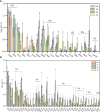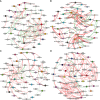Anatomical, chemical and endophytic fungal diversity of a Qi-Nan clone of Aquilaria sinensis (Lour.) Spreng with different induction times
- PMID: 38590741
- PMCID: PMC10999641
- DOI: 10.3389/fpls.2024.1320226
Anatomical, chemical and endophytic fungal diversity of a Qi-Nan clone of Aquilaria sinensis (Lour.) Spreng with different induction times
Abstract
Recently, some new Qi-Nan clones of Aquilaria sinensis (Lour.) Spreng which intensively produces high-quality agarwood have been identified and propagated through grafting techniques. Previous studies have primarily focused on ordinary A. sinensis and the differences in composition when compared to Qi-Nan and ordinary A. sinensis. There are few studies on the formation mechanism of Qi-Nan agarwood and the dynamic changes in components and endophytic fungi during the induction process. In this paper, the characteristics, chemical composition, and changes in endophytic fungi of Qi-Nan agarwood induced after 1 year, 2 years, and 3 years were studied, and Qi-Nan white wood was used as the control. The results showed that the yield of Qi-Nan agarwood continued to increase with the induction time over a period of 3 years, while the content of alcohol extract from Qi-Nan agarwood reached its peak at two years. During the formation of agarwood, starch and soluble sugars in xylem rays and interxylary phloem are consumed and reduced. Most of the oily substances in agarwood were filled in xylem ray cells and interxylary phloem, and a small amount was filled in xylem vessels. The main components of Qi-Nan agarwood are also chromones and sesquiterpenes. With an increasing induction time, the content of sesquiterpenes increased, while the content of chromones decreased. The most abundant chromones in Qi-Nan agarwood were 2-(2-Phenethyl) chromone, 2-[2-(3-Methoxy-4-hydroxyphenyl) ethyl] chromone, and2-[2-(4-Methoxyphenyl) ethyl] chromone. Significant differences were observed in the species of the endophytic fungi found in Qi-Nan agarwood at different induction times. A total of 4 phyla, 73 orders, and 448 genera were found in Qi-Nan agarwood dominated by Ascomycota and Basidiomycota. Different induction times had a significant effect on the diversity of the endophytic fungal community in Qi-Nan. After the induction of agarwood formation, the diversity of Qi-Nan endophytic fungi decreased. Correlation analysis showed that there was a significant positive correlation between endophytic fungi and the yield, alcohol extract content, sesquiterpene content, and chromone content of Qi-Nan agarwood, which indicated that endophytic fungi play a role in promoting the formation of Qi-Nan agarwood. Qi-Nan agarwood produced at different induction times exhibited strong antioxidant capacity. DPPH free radical scavenging activity and reactive oxygen species clearance activity were significantly positively correlated with the content of sesquiterpenes and chromones in Qi-Nan agarwood.
Keywords: Aquilaria sinensis; Qi-Nan; antioxidant activity; chemical composition; endophytic fungi.
Copyright © 2024 Li, Fang, Cui, Hong, Liu, Li, Hu and Xu.
Conflict of interest statement
The authors declare that the research was conducted in the absence of any commercial or financial relationships that could be construed as a potential conflict of interest.
Figures











References
-
- Adams S. J., Manohara T. N., Krishnamurthy K. V., Kumar T. S. (2016). Hitochemical studies on fungal-induced agarwood. Indian J. Plant Sci. 5, 102–110. Available at: http://www.cibtech.org/jps.htm.
-
- Blanchette R. A. (1992). “Anatomical responses of xylem to injury and invasion by fungi,” in Defense mechanisms of woody plants against fungi. Eds. Blanchette R., Biggs A. (Springer, Berlin: ), 76–95. doi: 10.1007/978-3-662-01642-8-5 - DOI
LinkOut - more resources
Full Text Sources

